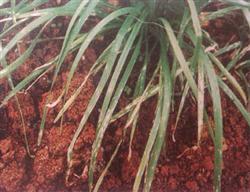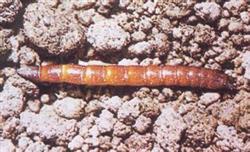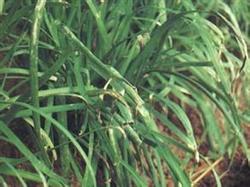Pollution-free control techniques of gray mold of leek

The main results are as follows: (1) the symptoms and epidemic rules are mainly harmful leaves, which can be divided into three types: White spot type, which forms water-stained gray spots on both sides of leaves, oval or fusiform, the periphery is light yellow, and the disease spot expands in the later stage, causing half-leaf or whole leaf to die. Sparse gray mold layer occurs when it is wet. The dry tip type is a downward disease at the cutting edge of the stubble, showing a water stain at first, then turning light green, and then expanding with brown edge spots or "V" shaped disease spots, causing the whole leaf to dry up and the diseased leaves near the surface to form a gray mildew layer. Wet rot type, under the condition of high humidity, all the leaves near the surface form dark green water-stained soft rot, with stench and dense gray mildew layer. Pathogenic fungi spread through airflow, irrigation and agricultural operations, resulting in the disease of healthy leaves. The leek is highly airtight in winter and spring, the greenhouse is warm, the greenhouse film is dripping, and the leaf surface with water film is suitable for the epidemic of diseases. Once the disease of perennial leek occurs, the bacterial source accumulates, and the disease becomes more serious in the following years, especially under the conditions of low temperature, high humidity, lack of sunshine and poor ventilation in the greenhouse in early spring. (2) ① agricultural prevention and control timely ventilation to reduce humidity is an important measure for disease prevention. In order to control humidity, sufficient water is poured before the shed, and water is controlled after the shed, especially after each harvest. It is forbidden to release bottom wind in the shed. The soil should be cultivated carefully in order to avoid damage to the leaves. The leek should be harvested in time, and then the disease and residual leaves should be thoroughly removed to reduce the source of bacteria. Increase the application of organic fertilizer to prevent partial application of nitrogen fertilizer, the formation of tender leaves susceptible to disease; summer leek to weed, topdressing, watering roots. ② chemical control in winter and spring, when the plant height of the first knife leek is 4-7 cm, and when the second knife leek is 6-8 days after harvest, the chemical control should be used in time. In cloudy and rainy days, use 10% Chlorothalonil smoke agent, 250 grams per 667 square meters, put 6-8 points, light with dark fire, close the shed, fumigate for 3-4 hours. Can also be sprayed in the evening 10% carbendazim dust, or 6.5% bacteria. Aldicarb dust, 1000 grams per 667m2; 1200 times dimethylpyrimidine suspension can be used in sunny days. Or 65% sulfur bacteria? 1000-fold liquid of aldicarb wettable powder or 1000-1600 times liquid spray of 50% propofoin wettable powder, focusing on spraying new leaves and surrounding soil, continuous prevention and treatment for 2-3 times according to the disease. It should be ventilated and damp on a sunny day after spraying. Spray once every 7 days and use alternately with other control methods for 2-3 times.
- Prev

Control methods of Golden Needle insect in Chinese chives
The root was irrigated with 1000 times of phoxim, 1000 times of trichlorfon, 4000 times of 50% cyanohydrin EC, 3000 times of chlorpromazine and 2.5 times of trichlorfon. Before sowing or planting, you can also use the above agent mixed with poison bait or coated with seed coating agent.
- Next

Control methods of Botrytis cinerea in Chinese chives
The protected land was fumigated with 10% Sukeling fumigant, 250g per mu, and foliar spraying with 50% Sukeling wettable powder powder 1000 times, 2% Wuyimycin (BO-10) 150x, 40% Botrytis cinerea 500-800x, 10% Polaroid 500-700x, 50% Nongliling 1200-1400 times.
Related
- Where is it suitable to grow horseradish in China? it is expected to see the middle altitude horseradish in Alishan.
- How to prevent tomato virus disease reasonably? (Control methods included)
- Many people like to plant towel gourd on the balcony. What are the main points of this method and management?
- What crops can chili peppers be mixed with?
- Fertilization techniques and matters needing attention in Tomato
- What are the grafting techniques for peach seedlings in spring?
- Harm and control methods of root swelling disease of Chinese cabbage
- What are the pests of sweet potatoes? How to prevent and cure it?
- Symptoms, causes and Control methods of navel Rot in Tomato
- The cause of "Cucumber rotten bibcock" in Farmers' planting Cucumber and its Control Plan

